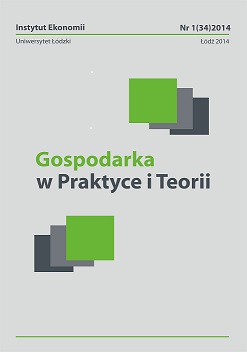Determinanty synchronizacji cykli koniunkturalnych w krajach Unii Europejskiej w latach 1990–2007
DOI:
https://doi.org/10.18778/1429-3730.34.01Słowa kluczowe:
gospodarka Unii Europejskiej, synchronizacja cykli koniunkturalnychAbstrakt
Celem niniejszego artykułu jest wykorzystanie metody pozornie niezależnych regresji (seemingly unrelated regressions) do zbadania determinant synchronizacji cykli koniunkturalnych w krajach Unii Europejskiej. Zastosowanie podejścia systemowego wykazało, że klasyczne determinanty synchronizacji cykli koniunkturalnych, tzn. natężenie handlu, podobieństwo struktur gospodarczych, kompatybilność polityki fiskalnej oraz monetarnej istotnie i pozytywnie wpływają na synchronizację cykli koniunkturalnych. Dodatkowo ujawnił się też wpływ konwergencji na synchronizacje cykli koniunkturalnych, wskazujący na poprawność hipotezy Imbsa i Wacziarga. Wraz z postępującą konwergencją struktury gospodarek najpierw się do siebie upodabniają, a po przekroczeniu pewnej granicy PKB per capita gospodarki zaczynają się specjalizować. W takiej sytuacji postępująca konwergencja za pośrednictwem specjalizacji będzie przekładać się na postępujący spadek synchronizacji cykli koniunkturalnych. Dodatkowo podobieństwa strukturalne przekładają się bardziej na symetryczny rozkład szoków pochodzących spoza Unii Europejskiej – podobieństwa strukturalne uniezależniają gospodarki Unii od wahań światowych.Bibliografia
Azali M., Lee G., The Endogeneity of The Optimum Currency Area Criteria in East Asia, Monash University Discussion paper, 2009, No. 15.
Google Scholar
Baxter, M., King R. Measuring Business Cycles: Approximate Band-Pass Filters for Economic Time Series, Review of Economics and Statistics, 1999, Vol. 81.
Google Scholar
DOI: https://doi.org/10.1162/003465399558454
Baxter, M., Kouparitsas M., Determinants of Business Cycle Comovement: A Robust Analysis, NBER Working Paper, 2004, No.10725.
Google Scholar
DOI: https://doi.org/10.3386/w10725
Bayoumi T., Eincheergreen B., Shocking Aspects of European Monetary Integration, NBER Working Paper, 1992, No. 3949.
Google Scholar
DOI: https://doi.org/10.3386/w3949
Bordo M., Helbling T., International Business Cycle Synchronization In Historical Perspective, NBER Working Paper, 2011, No. 16103.
Google Scholar
DOI: https://doi.org/10.3386/w16103
Böwer U., Guillemineau C., Determinants of Business Cycles Synchronization Across Euro Area Countries, EBC Working Papers, 2006, No. 587.
Google Scholar
DOI: https://doi.org/10.2139/ssrn.880429
Frankel J., Rose A., The Endogeneity of the Optimum Currency Area Criteria, NBER Working Papers, 1996, No. 5700.
Google Scholar
DOI: https://doi.org/10.3386/w5700
Friedman M., The Role of Monetary Policy, The American Economic Review, Vol. 58, 1968, No. 1.
Google Scholar
Heston A., Summers R. and Aten B., Penn World Table Version 7.1, Center for International Comparisons of Production, Income and Prices at the University of Pennsylvania, 2012.
Google Scholar
Hodrick R., Prescott E., Post-war U.S. Business Cycles: An Empirical investigation, Journal of Money, Credit and Banking, Vol. 29, 1997, No. 1.
Google Scholar
DOI: https://doi.org/10.2307/2953682
Horvath R., Komarek L., Optimum currency area theory: an approach for thinking about monetary integration, Warwick Economic Research Papers, 2002, No. 647.
Google Scholar
Imbs, J., Wacziarg, R. Stages of Diversification, American Economic Review, Vol. 93, 2003, No. 1.
Google Scholar
DOI: https://doi.org/10.1257/000282803321455160
Imbs, J., Trade, Finance, Specialization, and Synchronization, Review of Economics and Statistics, Vol. 86, 2004, No. 3.
Google Scholar
DOI: https://doi.org/10.1162/0034653041811707
Kenen P., The Theory of Optimum Currency Areas: An Eclectic View, W: R. Mundell i A. Swoboda (Ed.). Monetary Problems in the International Economy, University of Chicago Press, Chicago 1969.
Google Scholar
Kraay, A., Ventura, J., Comparative Advantage and the Cross-Section of Business Cycles, NBER Working Paper, 2002, No. 8104.
Google Scholar
DOI: https://doi.org/10.3386/w8104
Krugman P., Lessons of Massachusetts for EMU, W: F. Torres i F. Giavazzi (Ed.) Adjustment and growth in the European Monetary Union, Cambridge University Press, Cambridge 1993.
Google Scholar
DOI: https://doi.org/10.1017/CBO9780511599231.016
Lehwald S., Has the Euro Changed Business Cycle Synchronization? Evidence from the Core and the Periphery, IFO Working Papers, 2012, No. 122.
Google Scholar
DOI: https://doi.org/10.1007/s10663-012-9205-8
Lucas R., Expectations and the Neutrality of Money, Journal of Economic Theory, Vol. 4, 1972, No. 2.
Google Scholar
DOI: https://doi.org/10.1016/0022-0531(72)90142-1
McKinnon R., Optimum Currency Areas, American Economic Review Vol. 53, No. 4, 1963.
Google Scholar
Mendonça A., Passos J., Silvestre J., The Shrinking Endogeneity of Optimum Currency Areas Criteria: Evidence from the European Monetary Union – A Beta Regression Approach, ISEG Working Paper, 2007, No. 022.
Google Scholar
Mundell R., A Theory of Optimum Currency Areas, American Economic Review, Vol. 51, 1961, No. 4.
Google Scholar
Nées, S., Zorell, N., Business Cycles Synchronization. Disentangling Trade and Financial Linkages, EBC Working Paper, 2011, No. 1322.
Google Scholar
DOI: https://doi.org/10.2139/ssrn.1793864
One market, one money. An evaluation of the potential benefits and costs of forming an economic and monetary union, 1990, European Economy No. 44.
Google Scholar
Phelps E., Phillips Curves, Expectations of Inflation and Optimal Unemployment over Time, Economica, Vol. 34., 1967, No. 135.
Google Scholar
DOI: https://doi.org/10.2307/2552025
Sachs A., Schleer F., Labour Market Institutions and Structural Reforms: A Source for Business Cycle Synchronization?, International Journal of Applied Economics, March 2013, 10(1).
Google Scholar
Siedschlag I., Patterns and Determinants of Business Cycles Synchronization in Enlarged European and Monetary Union, Eastern Journal of European Studies, Vol. 1, 2010, No. 1.
Google Scholar
Tavlas G., The ‘New’ Theory of Optimum Currency Areas, World Economy, Vol. 16, 1993, No. 6.
Google Scholar
DOI: https://doi.org/10.1111/j.1467-9701.1993.tb00189.x
Pobrania
Opublikowane
Jak cytować
Numer
Dział
Licencja
Prawa autorskie (c) 2014 Gospodarka w Praktyce i Teorii

Utwór dostępny jest na licencji Creative Commons Uznanie autorstwa – Użycie niekomercyjne – Bez utworów zależnych 4.0 Międzynarodowe.








